Accounting Practices, Business Responsibilities, and Legal Frameworks
VerifiedAdded on 2019/11/08
|12
|2988
|179
Report
AI Summary
This report delves into the multifaceted responsibilities of business organizations towards their stakeholders, emphasizing the critical role of accounting practices and legal frameworks in ensuring ethical and compliant operations. It explores the significance of adhering to legislations like the Corporations Act 2001 and Income Tax Assessment Act, as well as professional ethics, particularly within the Australian context. The report highlights the role of the Australian Accounting Standards Board (AASB) in standardizing financial reporting to improve transparency and comparability. It differentiates between the Income Tax Assessment Act and the PAYG system, elucidating their distinct objectives and functionalities. Furthermore, the report underscores the importance of accounting standards and legislations in protecting government interests and promoting economic development by ensuring clarity in financial transactions and tax compliance. The report offers a comprehensive overview of the intersection between business operations, legal requirements, and accounting practices, emphasizing their collective impact on stakeholder management and financial integrity.

Running Head: ACCOUNTING
Accounting
Name of the Student:
Name of the University:
Authors Note:
Accounting
Name of the Student:
Name of the University:
Authors Note:
Paraphrase This Document
Need a fresh take? Get an instant paraphrase of this document with our AI Paraphraser

2MANAGEMENT
Table of Contents
Part 1:...............................................................................................................................................3
Part 2:...............................................................................................................................................7
References:....................................................................................................................................11
Table of Contents
Part 1:...............................................................................................................................................3
Part 2:...............................................................................................................................................7
References:....................................................................................................................................11
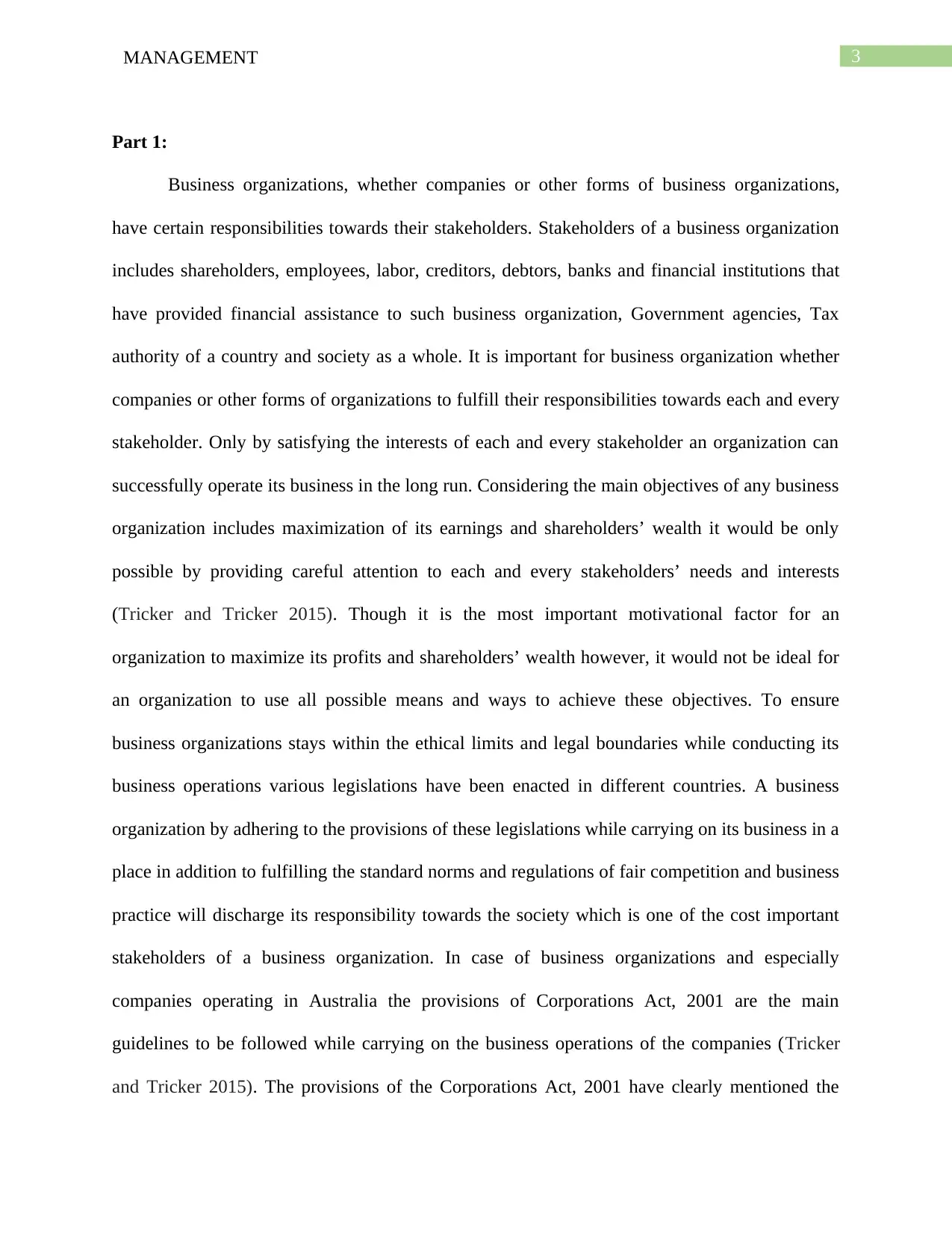
3MANAGEMENT
Part 1:
Business organizations, whether companies or other forms of business organizations,
have certain responsibilities towards their stakeholders. Stakeholders of a business organization
includes shareholders, employees, labor, creditors, debtors, banks and financial institutions that
have provided financial assistance to such business organization, Government agencies, Tax
authority of a country and society as a whole. It is important for business organization whether
companies or other forms of organizations to fulfill their responsibilities towards each and every
stakeholder. Only by satisfying the interests of each and every stakeholder an organization can
successfully operate its business in the long run. Considering the main objectives of any business
organization includes maximization of its earnings and shareholders’ wealth it would be only
possible by providing careful attention to each and every stakeholders’ needs and interests
(Tricker and Tricker 2015). Though it is the most important motivational factor for an
organization to maximize its profits and shareholders’ wealth however, it would not be ideal for
an organization to use all possible means and ways to achieve these objectives. To ensure
business organizations stays within the ethical limits and legal boundaries while conducting its
business operations various legislations have been enacted in different countries. A business
organization by adhering to the provisions of these legislations while carrying on its business in a
place in addition to fulfilling the standard norms and regulations of fair competition and business
practice will discharge its responsibility towards the society which is one of the cost important
stakeholders of a business organization. In case of business organizations and especially
companies operating in Australia the provisions of Corporations Act, 2001 are the main
guidelines to be followed while carrying on the business operations of the companies (Tricker
and Tricker 2015). The provisions of the Corporations Act, 2001 have clearly mentioned the
Part 1:
Business organizations, whether companies or other forms of business organizations,
have certain responsibilities towards their stakeholders. Stakeholders of a business organization
includes shareholders, employees, labor, creditors, debtors, banks and financial institutions that
have provided financial assistance to such business organization, Government agencies, Tax
authority of a country and society as a whole. It is important for business organization whether
companies or other forms of organizations to fulfill their responsibilities towards each and every
stakeholder. Only by satisfying the interests of each and every stakeholder an organization can
successfully operate its business in the long run. Considering the main objectives of any business
organization includes maximization of its earnings and shareholders’ wealth it would be only
possible by providing careful attention to each and every stakeholders’ needs and interests
(Tricker and Tricker 2015). Though it is the most important motivational factor for an
organization to maximize its profits and shareholders’ wealth however, it would not be ideal for
an organization to use all possible means and ways to achieve these objectives. To ensure
business organizations stays within the ethical limits and legal boundaries while conducting its
business operations various legislations have been enacted in different countries. A business
organization by adhering to the provisions of these legislations while carrying on its business in a
place in addition to fulfilling the standard norms and regulations of fair competition and business
practice will discharge its responsibility towards the society which is one of the cost important
stakeholders of a business organization. In case of business organizations and especially
companies operating in Australia the provisions of Corporations Act, 2001 are the main
guidelines to be followed while carrying on the business operations of the companies (Tricker
and Tricker 2015). The provisions of the Corporations Act, 2001 have clearly mentioned the
⊘ This is a preview!⊘
Do you want full access?
Subscribe today to unlock all pages.

Trusted by 1+ million students worldwide
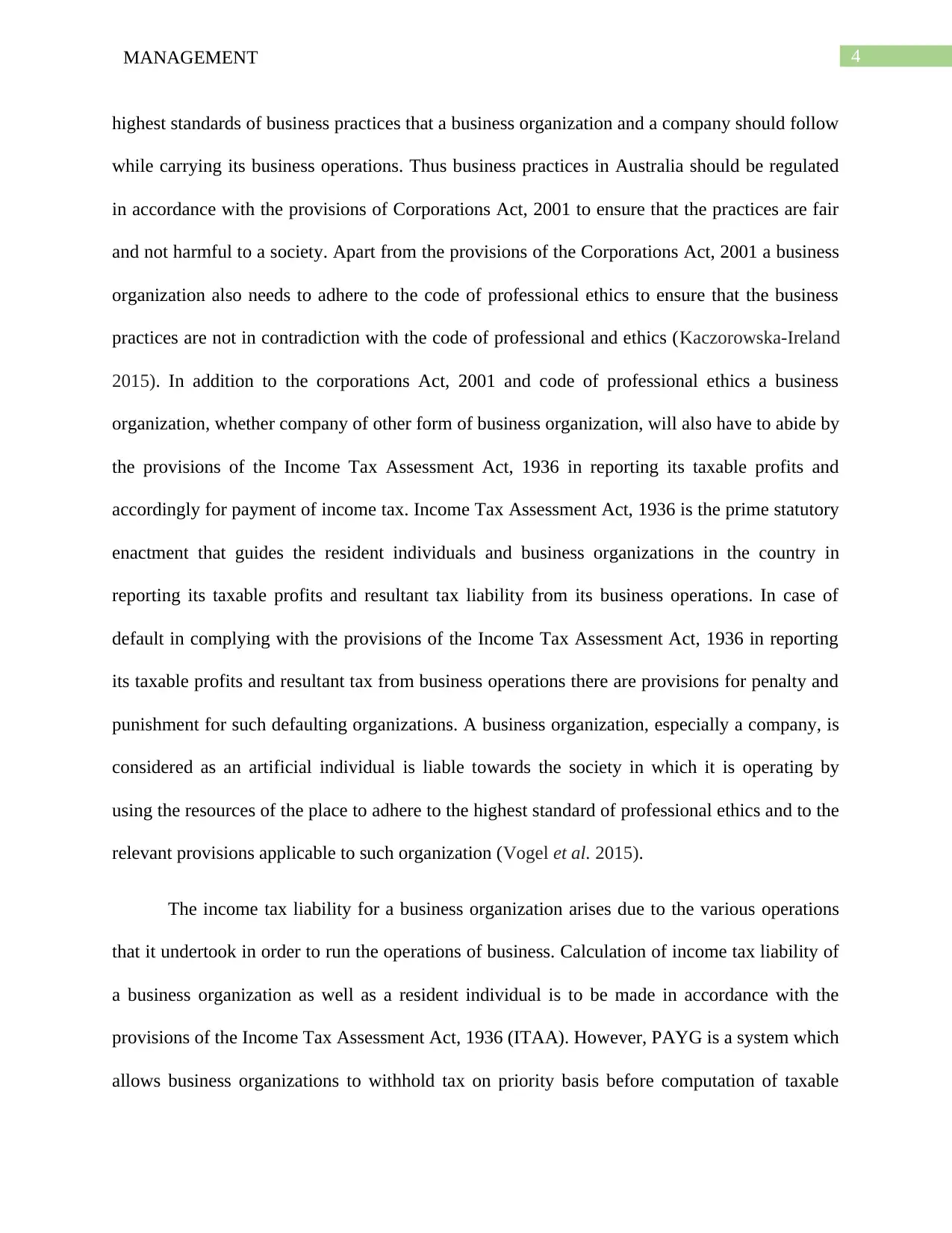
4MANAGEMENT
highest standards of business practices that a business organization and a company should follow
while carrying its business operations. Thus business practices in Australia should be regulated
in accordance with the provisions of Corporations Act, 2001 to ensure that the practices are fair
and not harmful to a society. Apart from the provisions of the Corporations Act, 2001 a business
organization also needs to adhere to the code of professional ethics to ensure that the business
practices are not in contradiction with the code of professional and ethics (Kaczorowska-Ireland
2015). In addition to the corporations Act, 2001 and code of professional ethics a business
organization, whether company of other form of business organization, will also have to abide by
the provisions of the Income Tax Assessment Act, 1936 in reporting its taxable profits and
accordingly for payment of income tax. Income Tax Assessment Act, 1936 is the prime statutory
enactment that guides the resident individuals and business organizations in the country in
reporting its taxable profits and resultant tax liability from its business operations. In case of
default in complying with the provisions of the Income Tax Assessment Act, 1936 in reporting
its taxable profits and resultant tax from business operations there are provisions for penalty and
punishment for such defaulting organizations. A business organization, especially a company, is
considered as an artificial individual is liable towards the society in which it is operating by
using the resources of the place to adhere to the highest standard of professional ethics and to the
relevant provisions applicable to such organization (Vogel et al. 2015).
The income tax liability for a business organization arises due to the various operations
that it undertook in order to run the operations of business. Calculation of income tax liability of
a business organization as well as a resident individual is to be made in accordance with the
provisions of the Income Tax Assessment Act, 1936 (ITAA). However, PAYG is a system which
allows business organizations to withhold tax on priority basis before computation of taxable
highest standards of business practices that a business organization and a company should follow
while carrying its business operations. Thus business practices in Australia should be regulated
in accordance with the provisions of Corporations Act, 2001 to ensure that the practices are fair
and not harmful to a society. Apart from the provisions of the Corporations Act, 2001 a business
organization also needs to adhere to the code of professional ethics to ensure that the business
practices are not in contradiction with the code of professional and ethics (Kaczorowska-Ireland
2015). In addition to the corporations Act, 2001 and code of professional ethics a business
organization, whether company of other form of business organization, will also have to abide by
the provisions of the Income Tax Assessment Act, 1936 in reporting its taxable profits and
accordingly for payment of income tax. Income Tax Assessment Act, 1936 is the prime statutory
enactment that guides the resident individuals and business organizations in the country in
reporting its taxable profits and resultant tax liability from its business operations. In case of
default in complying with the provisions of the Income Tax Assessment Act, 1936 in reporting
its taxable profits and resultant tax from business operations there are provisions for penalty and
punishment for such defaulting organizations. A business organization, especially a company, is
considered as an artificial individual is liable towards the society in which it is operating by
using the resources of the place to adhere to the highest standard of professional ethics and to the
relevant provisions applicable to such organization (Vogel et al. 2015).
The income tax liability for a business organization arises due to the various operations
that it undertook in order to run the operations of business. Calculation of income tax liability of
a business organization as well as a resident individual is to be made in accordance with the
provisions of the Income Tax Assessment Act, 1936 (ITAA). However, PAYG is a system which
allows business organizations to withhold tax on priority basis before computation of taxable
Paraphrase This Document
Need a fresh take? Get an instant paraphrase of this document with our AI Paraphraser
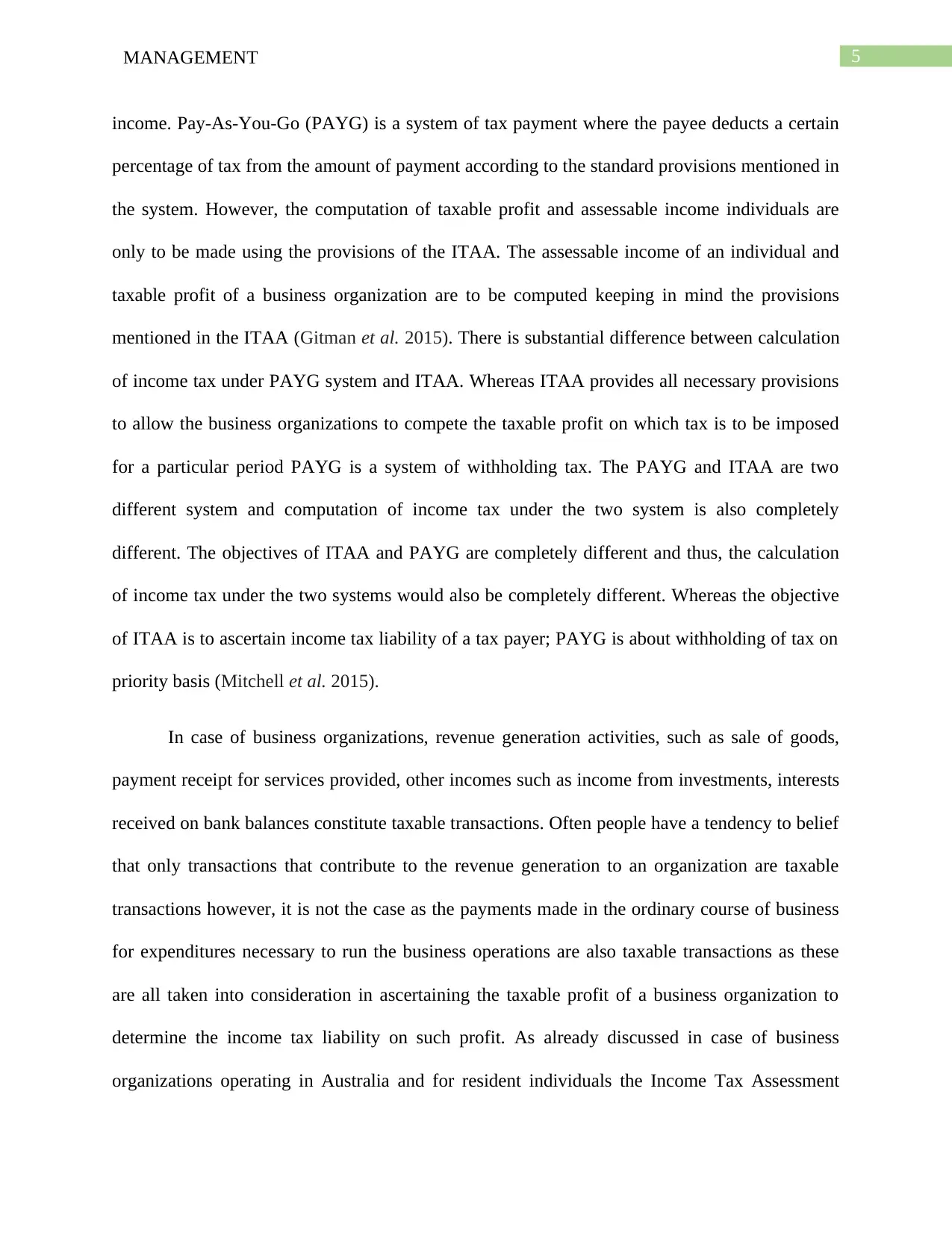
5MANAGEMENT
income. Pay-As-You-Go (PAYG) is a system of tax payment where the payee deducts a certain
percentage of tax from the amount of payment according to the standard provisions mentioned in
the system. However, the computation of taxable profit and assessable income individuals are
only to be made using the provisions of the ITAA. The assessable income of an individual and
taxable profit of a business organization are to be computed keeping in mind the provisions
mentioned in the ITAA (Gitman et al. 2015). There is substantial difference between calculation
of income tax under PAYG system and ITAA. Whereas ITAA provides all necessary provisions
to allow the business organizations to compete the taxable profit on which tax is to be imposed
for a particular period PAYG is a system of withholding tax. The PAYG and ITAA are two
different system and computation of income tax under the two system is also completely
different. The objectives of ITAA and PAYG are completely different and thus, the calculation
of income tax under the two systems would also be completely different. Whereas the objective
of ITAA is to ascertain income tax liability of a tax payer; PAYG is about withholding of tax on
priority basis (Mitchell et al. 2015).
In case of business organizations, revenue generation activities, such as sale of goods,
payment receipt for services provided, other incomes such as income from investments, interests
received on bank balances constitute taxable transactions. Often people have a tendency to belief
that only transactions that contribute to the revenue generation to an organization are taxable
transactions however, it is not the case as the payments made in the ordinary course of business
for expenditures necessary to run the business operations are also taxable transactions as these
are all taken into consideration in ascertaining the taxable profit of a business organization to
determine the income tax liability on such profit. As already discussed in case of business
organizations operating in Australia and for resident individuals the Income Tax Assessment
income. Pay-As-You-Go (PAYG) is a system of tax payment where the payee deducts a certain
percentage of tax from the amount of payment according to the standard provisions mentioned in
the system. However, the computation of taxable profit and assessable income individuals are
only to be made using the provisions of the ITAA. The assessable income of an individual and
taxable profit of a business organization are to be computed keeping in mind the provisions
mentioned in the ITAA (Gitman et al. 2015). There is substantial difference between calculation
of income tax under PAYG system and ITAA. Whereas ITAA provides all necessary provisions
to allow the business organizations to compete the taxable profit on which tax is to be imposed
for a particular period PAYG is a system of withholding tax. The PAYG and ITAA are two
different system and computation of income tax under the two system is also completely
different. The objectives of ITAA and PAYG are completely different and thus, the calculation
of income tax under the two systems would also be completely different. Whereas the objective
of ITAA is to ascertain income tax liability of a tax payer; PAYG is about withholding of tax on
priority basis (Mitchell et al. 2015).
In case of business organizations, revenue generation activities, such as sale of goods,
payment receipt for services provided, other incomes such as income from investments, interests
received on bank balances constitute taxable transactions. Often people have a tendency to belief
that only transactions that contribute to the revenue generation to an organization are taxable
transactions however, it is not the case as the payments made in the ordinary course of business
for expenditures necessary to run the business operations are also taxable transactions as these
are all taken into consideration in ascertaining the taxable profit of a business organization to
determine the income tax liability on such profit. As already discussed in case of business
organizations operating in Australia and for resident individuals the Income Tax Assessment
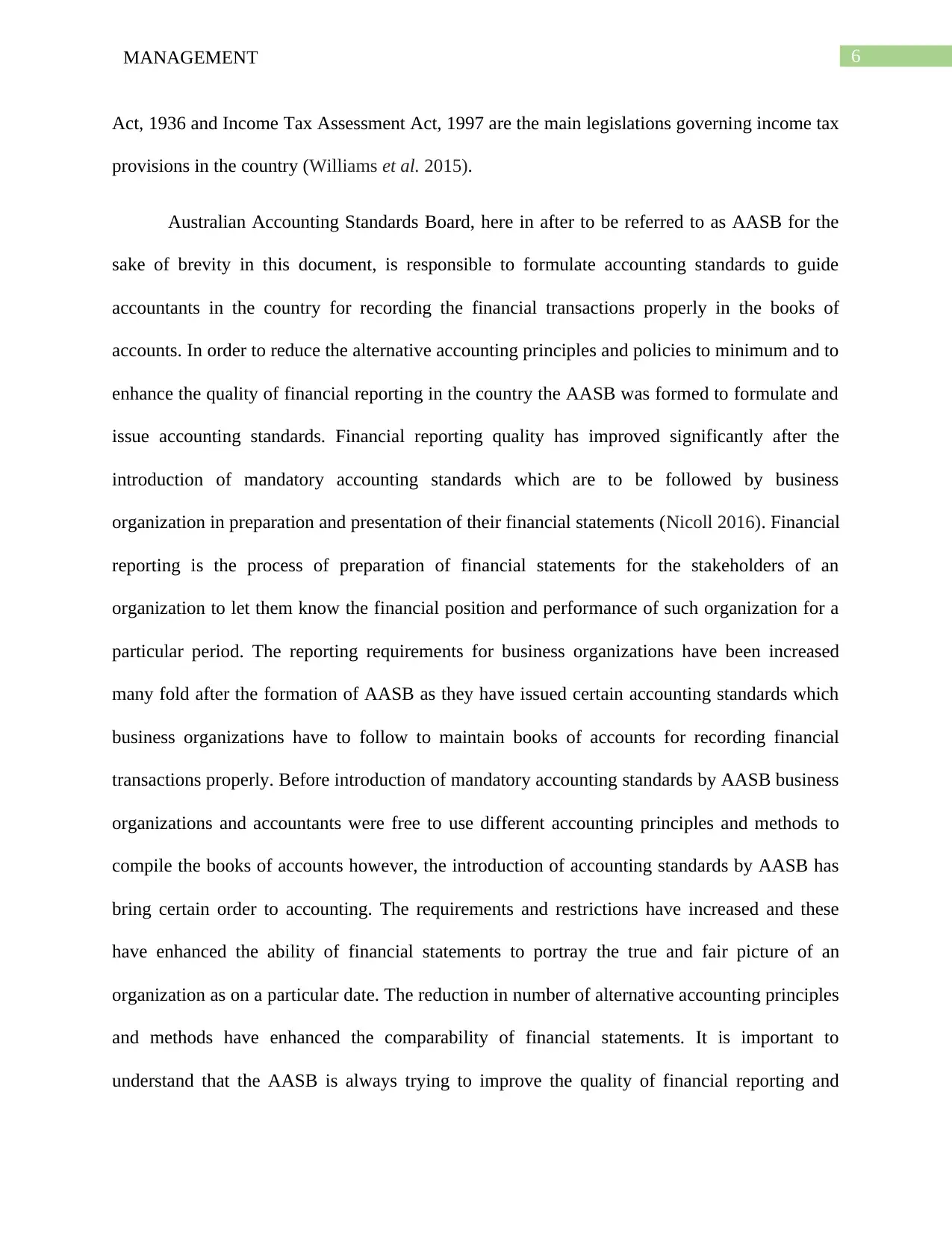
6MANAGEMENT
Act, 1936 and Income Tax Assessment Act, 1997 are the main legislations governing income tax
provisions in the country (Williams et al. 2015).
Australian Accounting Standards Board, here in after to be referred to as AASB for the
sake of brevity in this document, is responsible to formulate accounting standards to guide
accountants in the country for recording the financial transactions properly in the books of
accounts. In order to reduce the alternative accounting principles and policies to minimum and to
enhance the quality of financial reporting in the country the AASB was formed to formulate and
issue accounting standards. Financial reporting quality has improved significantly after the
introduction of mandatory accounting standards which are to be followed by business
organization in preparation and presentation of their financial statements (Nicoll 2016). Financial
reporting is the process of preparation of financial statements for the stakeholders of an
organization to let them know the financial position and performance of such organization for a
particular period. The reporting requirements for business organizations have been increased
many fold after the formation of AASB as they have issued certain accounting standards which
business organizations have to follow to maintain books of accounts for recording financial
transactions properly. Before introduction of mandatory accounting standards by AASB business
organizations and accountants were free to use different accounting principles and methods to
compile the books of accounts however, the introduction of accounting standards by AASB has
bring certain order to accounting. The requirements and restrictions have increased and these
have enhanced the ability of financial statements to portray the true and fair picture of an
organization as on a particular date. The reduction in number of alternative accounting principles
and methods have enhanced the comparability of financial statements. It is important to
understand that the AASB is always trying to improve the quality of financial reporting and
Act, 1936 and Income Tax Assessment Act, 1997 are the main legislations governing income tax
provisions in the country (Williams et al. 2015).
Australian Accounting Standards Board, here in after to be referred to as AASB for the
sake of brevity in this document, is responsible to formulate accounting standards to guide
accountants in the country for recording the financial transactions properly in the books of
accounts. In order to reduce the alternative accounting principles and policies to minimum and to
enhance the quality of financial reporting in the country the AASB was formed to formulate and
issue accounting standards. Financial reporting quality has improved significantly after the
introduction of mandatory accounting standards which are to be followed by business
organization in preparation and presentation of their financial statements (Nicoll 2016). Financial
reporting is the process of preparation of financial statements for the stakeholders of an
organization to let them know the financial position and performance of such organization for a
particular period. The reporting requirements for business organizations have been increased
many fold after the formation of AASB as they have issued certain accounting standards which
business organizations have to follow to maintain books of accounts for recording financial
transactions properly. Before introduction of mandatory accounting standards by AASB business
organizations and accountants were free to use different accounting principles and methods to
compile the books of accounts however, the introduction of accounting standards by AASB has
bring certain order to accounting. The requirements and restrictions have increased and these
have enhanced the ability of financial statements to portray the true and fair picture of an
organization as on a particular date. The reduction in number of alternative accounting principles
and methods have enhanced the comparability of financial statements. It is important to
understand that the AASB is always trying to improve the quality of financial reporting and
⊘ This is a preview!⊘
Do you want full access?
Subscribe today to unlock all pages.

Trusted by 1+ million students worldwide
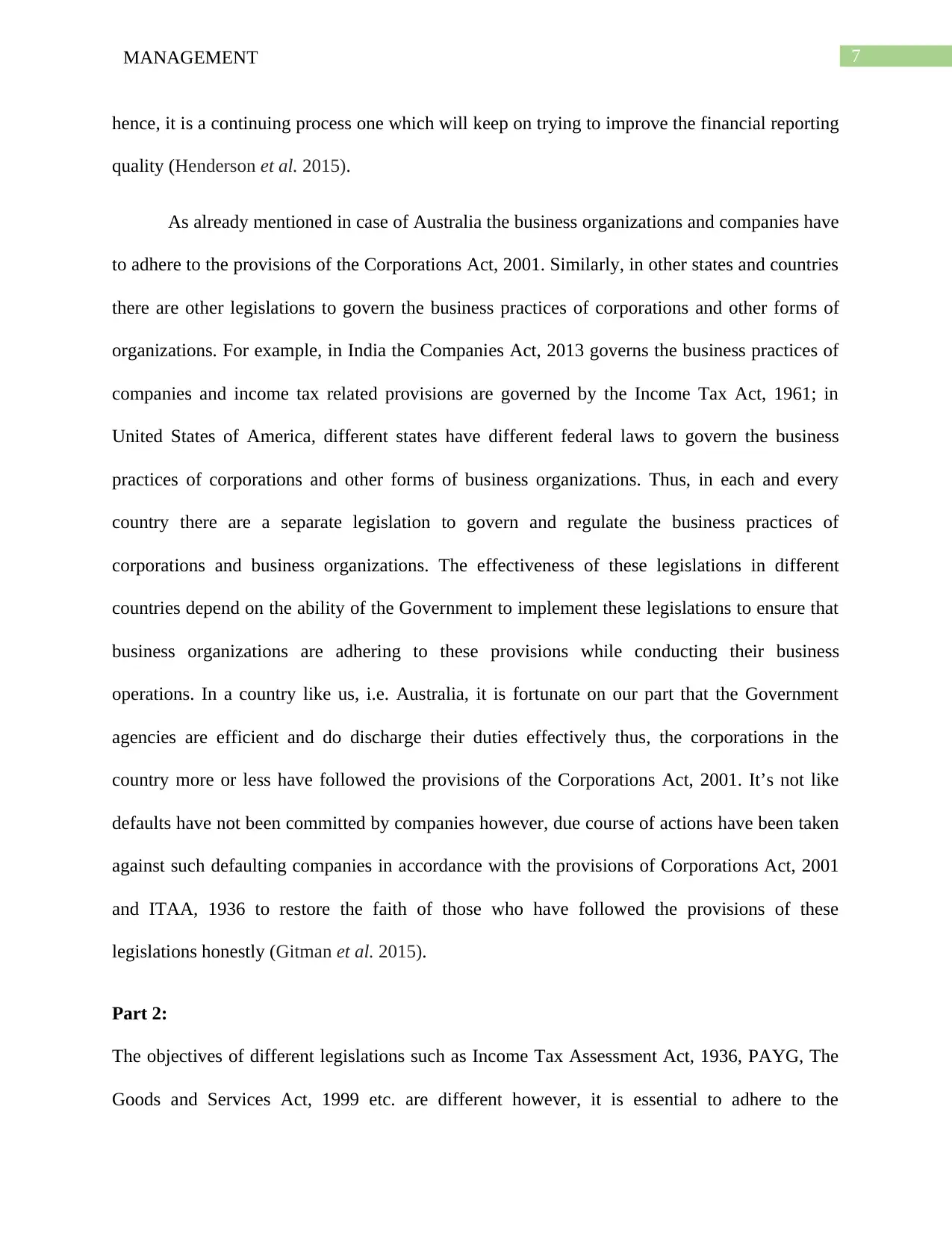
7MANAGEMENT
hence, it is a continuing process one which will keep on trying to improve the financial reporting
quality (Henderson et al. 2015).
As already mentioned in case of Australia the business organizations and companies have
to adhere to the provisions of the Corporations Act, 2001. Similarly, in other states and countries
there are other legislations to govern the business practices of corporations and other forms of
organizations. For example, in India the Companies Act, 2013 governs the business practices of
companies and income tax related provisions are governed by the Income Tax Act, 1961; in
United States of America, different states have different federal laws to govern the business
practices of corporations and other forms of business organizations. Thus, in each and every
country there are a separate legislation to govern and regulate the business practices of
corporations and business organizations. The effectiveness of these legislations in different
countries depend on the ability of the Government to implement these legislations to ensure that
business organizations are adhering to these provisions while conducting their business
operations. In a country like us, i.e. Australia, it is fortunate on our part that the Government
agencies are efficient and do discharge their duties effectively thus, the corporations in the
country more or less have followed the provisions of the Corporations Act, 2001. It’s not like
defaults have not been committed by companies however, due course of actions have been taken
against such defaulting companies in accordance with the provisions of Corporations Act, 2001
and ITAA, 1936 to restore the faith of those who have followed the provisions of these
legislations honestly (Gitman et al. 2015).
Part 2:
The objectives of different legislations such as Income Tax Assessment Act, 1936, PAYG, The
Goods and Services Act, 1999 etc. are different however, it is essential to adhere to the
hence, it is a continuing process one which will keep on trying to improve the financial reporting
quality (Henderson et al. 2015).
As already mentioned in case of Australia the business organizations and companies have
to adhere to the provisions of the Corporations Act, 2001. Similarly, in other states and countries
there are other legislations to govern the business practices of corporations and other forms of
organizations. For example, in India the Companies Act, 2013 governs the business practices of
companies and income tax related provisions are governed by the Income Tax Act, 1961; in
United States of America, different states have different federal laws to govern the business
practices of corporations and other forms of business organizations. Thus, in each and every
country there are a separate legislation to govern and regulate the business practices of
corporations and business organizations. The effectiveness of these legislations in different
countries depend on the ability of the Government to implement these legislations to ensure that
business organizations are adhering to these provisions while conducting their business
operations. In a country like us, i.e. Australia, it is fortunate on our part that the Government
agencies are efficient and do discharge their duties effectively thus, the corporations in the
country more or less have followed the provisions of the Corporations Act, 2001. It’s not like
defaults have not been committed by companies however, due course of actions have been taken
against such defaulting companies in accordance with the provisions of Corporations Act, 2001
and ITAA, 1936 to restore the faith of those who have followed the provisions of these
legislations honestly (Gitman et al. 2015).
Part 2:
The objectives of different legislations such as Income Tax Assessment Act, 1936, PAYG, The
Goods and Services Act, 1999 etc. are different however, it is essential to adhere to the
Paraphrase This Document
Need a fresh take? Get an instant paraphrase of this document with our AI Paraphraser
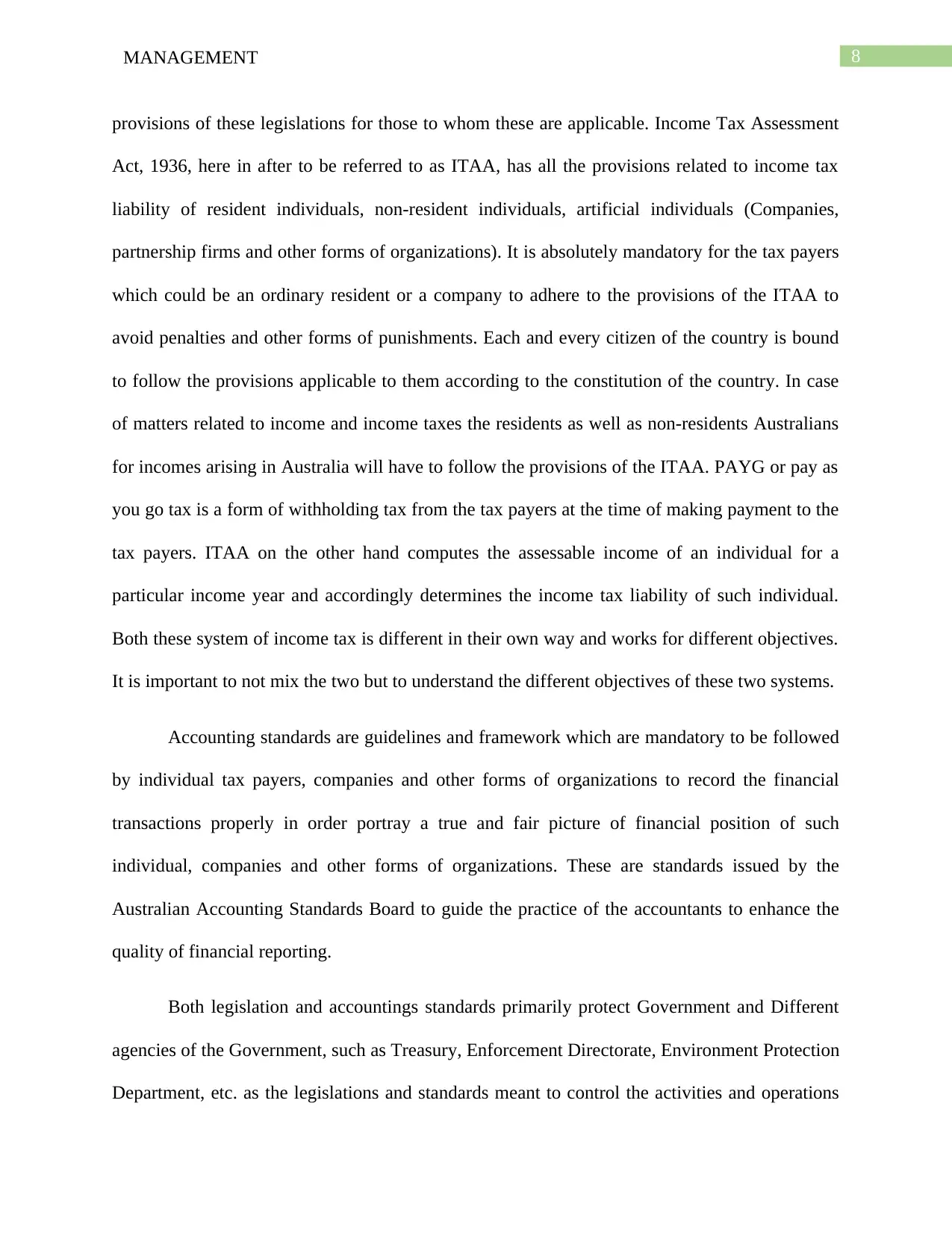
8MANAGEMENT
provisions of these legislations for those to whom these are applicable. Income Tax Assessment
Act, 1936, here in after to be referred to as ITAA, has all the provisions related to income tax
liability of resident individuals, non-resident individuals, artificial individuals (Companies,
partnership firms and other forms of organizations). It is absolutely mandatory for the tax payers
which could be an ordinary resident or a company to adhere to the provisions of the ITAA to
avoid penalties and other forms of punishments. Each and every citizen of the country is bound
to follow the provisions applicable to them according to the constitution of the country. In case
of matters related to income and income taxes the residents as well as non-residents Australians
for incomes arising in Australia will have to follow the provisions of the ITAA. PAYG or pay as
you go tax is a form of withholding tax from the tax payers at the time of making payment to the
tax payers. ITAA on the other hand computes the assessable income of an individual for a
particular income year and accordingly determines the income tax liability of such individual.
Both these system of income tax is different in their own way and works for different objectives.
It is important to not mix the two but to understand the different objectives of these two systems.
Accounting standards are guidelines and framework which are mandatory to be followed
by individual tax payers, companies and other forms of organizations to record the financial
transactions properly in order portray a true and fair picture of financial position of such
individual, companies and other forms of organizations. These are standards issued by the
Australian Accounting Standards Board to guide the practice of the accountants to enhance the
quality of financial reporting.
Both legislation and accountings standards primarily protect Government and Different
agencies of the Government, such as Treasury, Enforcement Directorate, Environment Protection
Department, etc. as the legislations and standards meant to control the activities and operations
provisions of these legislations for those to whom these are applicable. Income Tax Assessment
Act, 1936, here in after to be referred to as ITAA, has all the provisions related to income tax
liability of resident individuals, non-resident individuals, artificial individuals (Companies,
partnership firms and other forms of organizations). It is absolutely mandatory for the tax payers
which could be an ordinary resident or a company to adhere to the provisions of the ITAA to
avoid penalties and other forms of punishments. Each and every citizen of the country is bound
to follow the provisions applicable to them according to the constitution of the country. In case
of matters related to income and income taxes the residents as well as non-residents Australians
for incomes arising in Australia will have to follow the provisions of the ITAA. PAYG or pay as
you go tax is a form of withholding tax from the tax payers at the time of making payment to the
tax payers. ITAA on the other hand computes the assessable income of an individual for a
particular income year and accordingly determines the income tax liability of such individual.
Both these system of income tax is different in their own way and works for different objectives.
It is important to not mix the two but to understand the different objectives of these two systems.
Accounting standards are guidelines and framework which are mandatory to be followed
by individual tax payers, companies and other forms of organizations to record the financial
transactions properly in order portray a true and fair picture of financial position of such
individual, companies and other forms of organizations. These are standards issued by the
Australian Accounting Standards Board to guide the practice of the accountants to enhance the
quality of financial reporting.
Both legislation and accountings standards primarily protect Government and Different
agencies of the Government, such as Treasury, Enforcement Directorate, Environment Protection
Department, etc. as the legislations and standards meant to control the activities and operations
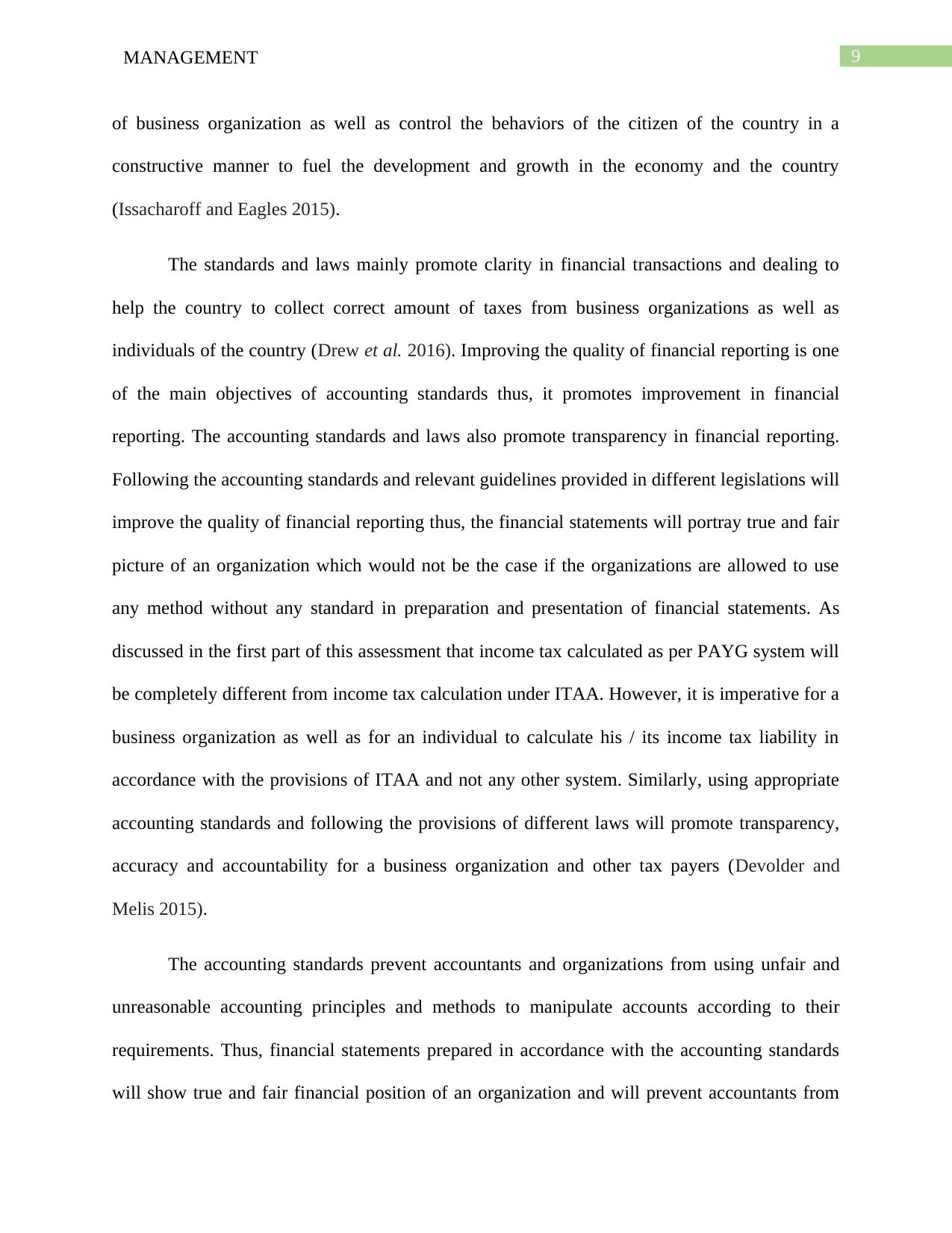
9MANAGEMENT
of business organization as well as control the behaviors of the citizen of the country in a
constructive manner to fuel the development and growth in the economy and the country
(Issacharoff and Eagles 2015).
The standards and laws mainly promote clarity in financial transactions and dealing to
help the country to collect correct amount of taxes from business organizations as well as
individuals of the country (Drew et al. 2016). Improving the quality of financial reporting is one
of the main objectives of accounting standards thus, it promotes improvement in financial
reporting. The accounting standards and laws also promote transparency in financial reporting.
Following the accounting standards and relevant guidelines provided in different legislations will
improve the quality of financial reporting thus, the financial statements will portray true and fair
picture of an organization which would not be the case if the organizations are allowed to use
any method without any standard in preparation and presentation of financial statements. As
discussed in the first part of this assessment that income tax calculated as per PAYG system will
be completely different from income tax calculation under ITAA. However, it is imperative for a
business organization as well as for an individual to calculate his / its income tax liability in
accordance with the provisions of ITAA and not any other system. Similarly, using appropriate
accounting standards and following the provisions of different laws will promote transparency,
accuracy and accountability for a business organization and other tax payers (Devolder and
Melis 2015).
The accounting standards prevent accountants and organizations from using unfair and
unreasonable accounting principles and methods to manipulate accounts according to their
requirements. Thus, financial statements prepared in accordance with the accounting standards
will show true and fair financial position of an organization and will prevent accountants from
of business organization as well as control the behaviors of the citizen of the country in a
constructive manner to fuel the development and growth in the economy and the country
(Issacharoff and Eagles 2015).
The standards and laws mainly promote clarity in financial transactions and dealing to
help the country to collect correct amount of taxes from business organizations as well as
individuals of the country (Drew et al. 2016). Improving the quality of financial reporting is one
of the main objectives of accounting standards thus, it promotes improvement in financial
reporting. The accounting standards and laws also promote transparency in financial reporting.
Following the accounting standards and relevant guidelines provided in different legislations will
improve the quality of financial reporting thus, the financial statements will portray true and fair
picture of an organization which would not be the case if the organizations are allowed to use
any method without any standard in preparation and presentation of financial statements. As
discussed in the first part of this assessment that income tax calculated as per PAYG system will
be completely different from income tax calculation under ITAA. However, it is imperative for a
business organization as well as for an individual to calculate his / its income tax liability in
accordance with the provisions of ITAA and not any other system. Similarly, using appropriate
accounting standards and following the provisions of different laws will promote transparency,
accuracy and accountability for a business organization and other tax payers (Devolder and
Melis 2015).
The accounting standards prevent accountants and organizations from using unfair and
unreasonable accounting principles and methods to manipulate accounts according to their
requirements. Thus, financial statements prepared in accordance with the accounting standards
will show true and fair financial position of an organization and will prevent accountants from
⊘ This is a preview!⊘
Do you want full access?
Subscribe today to unlock all pages.

Trusted by 1+ million students worldwide
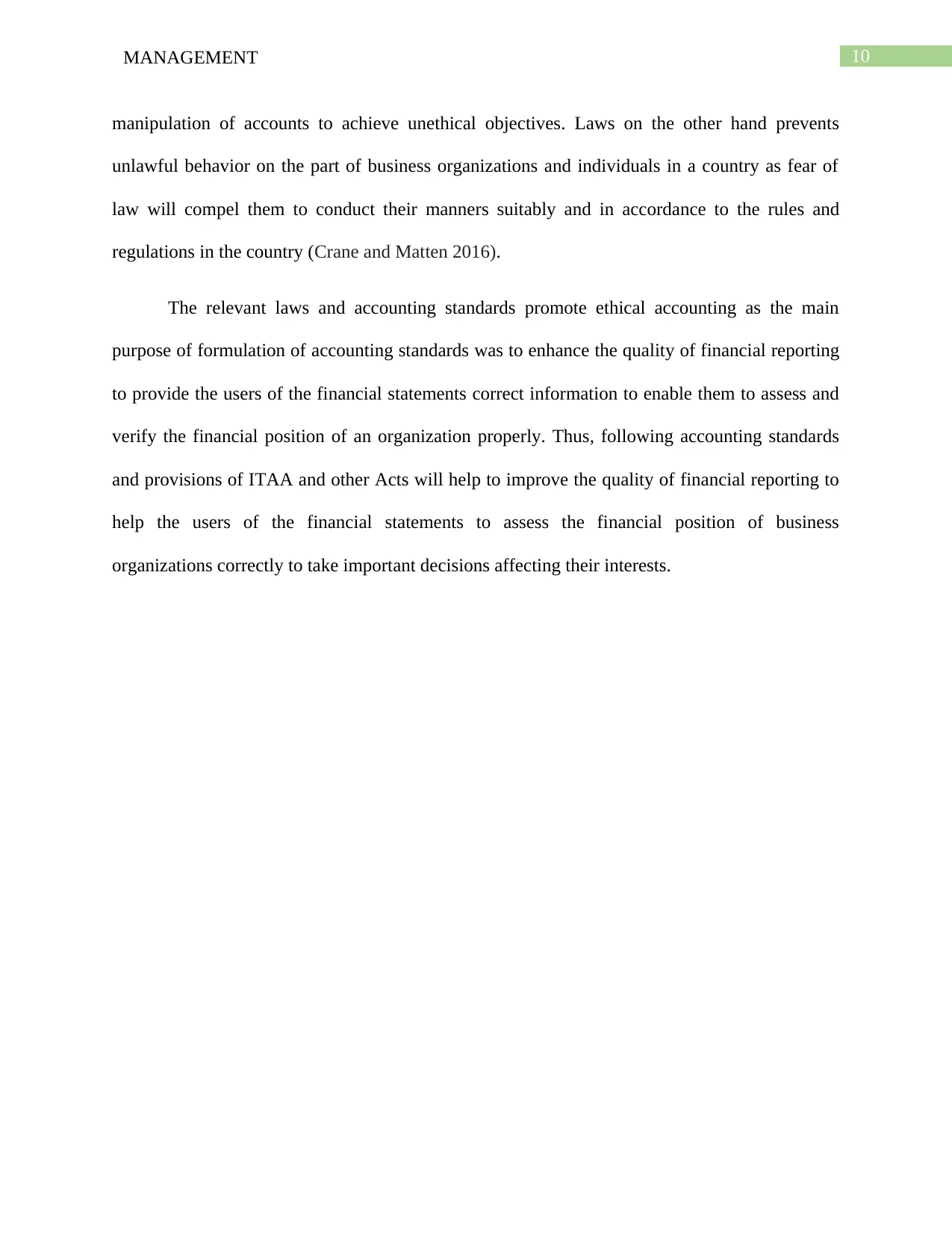
10MANAGEMENT
manipulation of accounts to achieve unethical objectives. Laws on the other hand prevents
unlawful behavior on the part of business organizations and individuals in a country as fear of
law will compel them to conduct their manners suitably and in accordance to the rules and
regulations in the country (Crane and Matten 2016).
The relevant laws and accounting standards promote ethical accounting as the main
purpose of formulation of accounting standards was to enhance the quality of financial reporting
to provide the users of the financial statements correct information to enable them to assess and
verify the financial position of an organization properly. Thus, following accounting standards
and provisions of ITAA and other Acts will help to improve the quality of financial reporting to
help the users of the financial statements to assess the financial position of business
organizations correctly to take important decisions affecting their interests.
manipulation of accounts to achieve unethical objectives. Laws on the other hand prevents
unlawful behavior on the part of business organizations and individuals in a country as fear of
law will compel them to conduct their manners suitably and in accordance to the rules and
regulations in the country (Crane and Matten 2016).
The relevant laws and accounting standards promote ethical accounting as the main
purpose of formulation of accounting standards was to enhance the quality of financial reporting
to provide the users of the financial statements correct information to enable them to assess and
verify the financial position of an organization properly. Thus, following accounting standards
and provisions of ITAA and other Acts will help to improve the quality of financial reporting to
help the users of the financial statements to assess the financial position of business
organizations correctly to take important decisions affecting their interests.
Paraphrase This Document
Need a fresh take? Get an instant paraphrase of this document with our AI Paraphraser
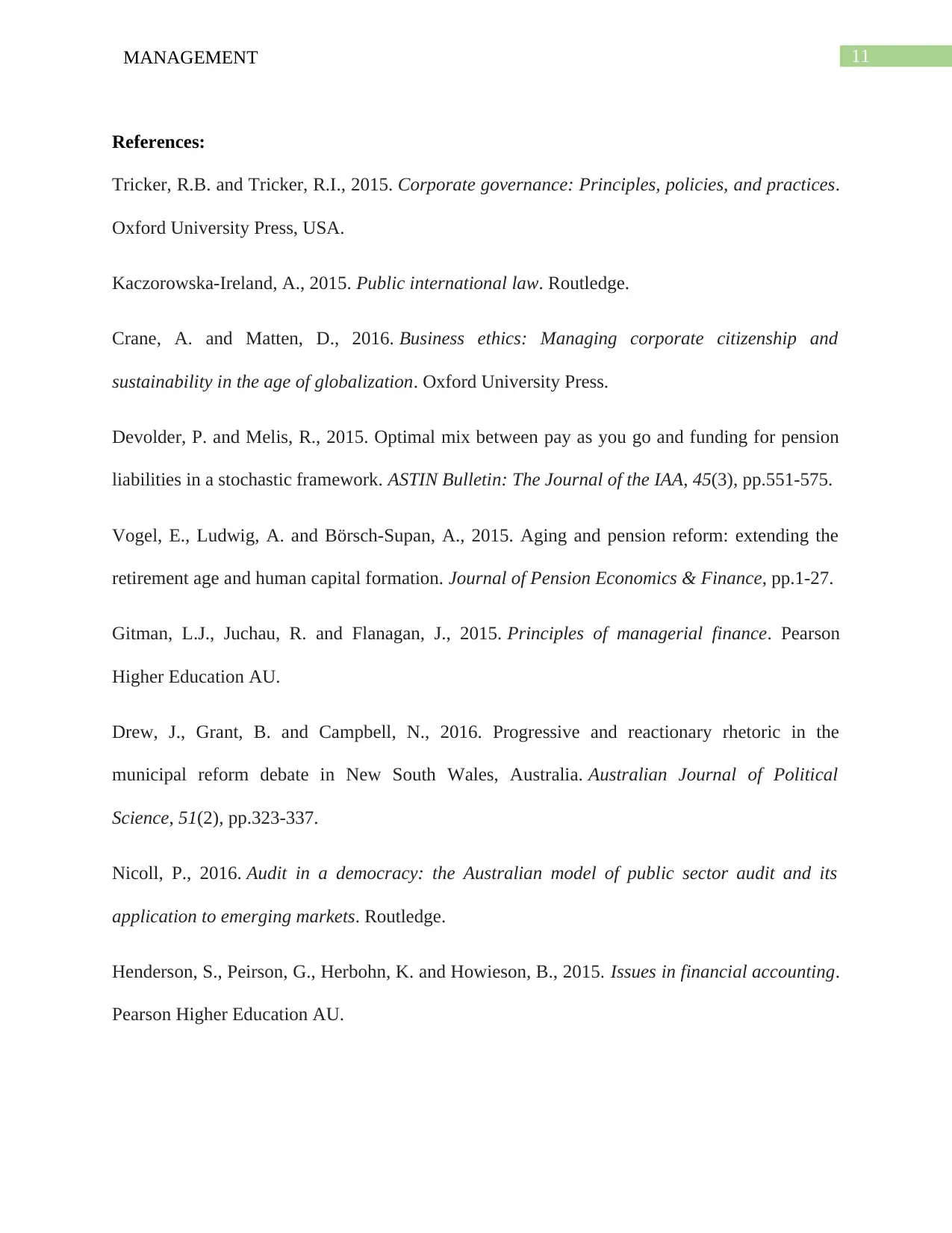
11MANAGEMENT
References:
Tricker, R.B. and Tricker, R.I., 2015. Corporate governance: Principles, policies, and practices.
Oxford University Press, USA.
Kaczorowska-Ireland, A., 2015. Public international law. Routledge.
Crane, A. and Matten, D., 2016. Business ethics: Managing corporate citizenship and
sustainability in the age of globalization. Oxford University Press.
Devolder, P. and Melis, R., 2015. Optimal mix between pay as you go and funding for pension
liabilities in a stochastic framework. ASTIN Bulletin: The Journal of the IAA, 45(3), pp.551-575.
Vogel, E., Ludwig, A. and Börsch-Supan, A., 2015. Aging and pension reform: extending the
retirement age and human capital formation. Journal of Pension Economics & Finance, pp.1-27.
Gitman, L.J., Juchau, R. and Flanagan, J., 2015. Principles of managerial finance. Pearson
Higher Education AU.
Drew, J., Grant, B. and Campbell, N., 2016. Progressive and reactionary rhetoric in the
municipal reform debate in New South Wales, Australia. Australian Journal of Political
Science, 51(2), pp.323-337.
Nicoll, P., 2016. Audit in a democracy: the Australian model of public sector audit and its
application to emerging markets. Routledge.
Henderson, S., Peirson, G., Herbohn, K. and Howieson, B., 2015. Issues in financial accounting.
Pearson Higher Education AU.
References:
Tricker, R.B. and Tricker, R.I., 2015. Corporate governance: Principles, policies, and practices.
Oxford University Press, USA.
Kaczorowska-Ireland, A., 2015. Public international law. Routledge.
Crane, A. and Matten, D., 2016. Business ethics: Managing corporate citizenship and
sustainability in the age of globalization. Oxford University Press.
Devolder, P. and Melis, R., 2015. Optimal mix between pay as you go and funding for pension
liabilities in a stochastic framework. ASTIN Bulletin: The Journal of the IAA, 45(3), pp.551-575.
Vogel, E., Ludwig, A. and Börsch-Supan, A., 2015. Aging and pension reform: extending the
retirement age and human capital formation. Journal of Pension Economics & Finance, pp.1-27.
Gitman, L.J., Juchau, R. and Flanagan, J., 2015. Principles of managerial finance. Pearson
Higher Education AU.
Drew, J., Grant, B. and Campbell, N., 2016. Progressive and reactionary rhetoric in the
municipal reform debate in New South Wales, Australia. Australian Journal of Political
Science, 51(2), pp.323-337.
Nicoll, P., 2016. Audit in a democracy: the Australian model of public sector audit and its
application to emerging markets. Routledge.
Henderson, S., Peirson, G., Herbohn, K. and Howieson, B., 2015. Issues in financial accounting.
Pearson Higher Education AU.
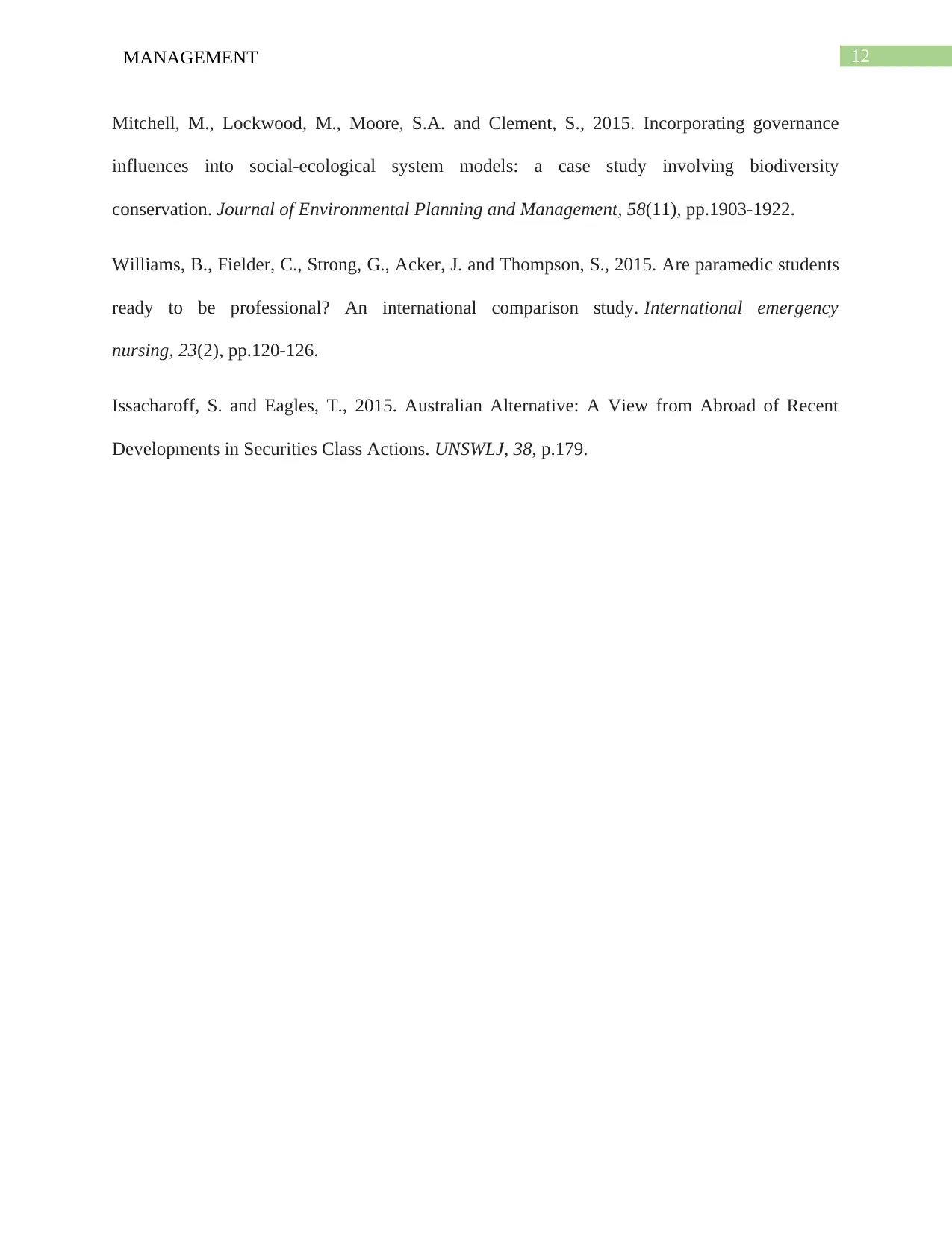
12MANAGEMENT
Mitchell, M., Lockwood, M., Moore, S.A. and Clement, S., 2015. Incorporating governance
influences into social-ecological system models: a case study involving biodiversity
conservation. Journal of Environmental Planning and Management, 58(11), pp.1903-1922.
Williams, B., Fielder, C., Strong, G., Acker, J. and Thompson, S., 2015. Are paramedic students
ready to be professional? An international comparison study. International emergency
nursing, 23(2), pp.120-126.
Issacharoff, S. and Eagles, T., 2015. Australian Alternative: A View from Abroad of Recent
Developments in Securities Class Actions. UNSWLJ, 38, p.179.
Mitchell, M., Lockwood, M., Moore, S.A. and Clement, S., 2015. Incorporating governance
influences into social-ecological system models: a case study involving biodiversity
conservation. Journal of Environmental Planning and Management, 58(11), pp.1903-1922.
Williams, B., Fielder, C., Strong, G., Acker, J. and Thompson, S., 2015. Are paramedic students
ready to be professional? An international comparison study. International emergency
nursing, 23(2), pp.120-126.
Issacharoff, S. and Eagles, T., 2015. Australian Alternative: A View from Abroad of Recent
Developments in Securities Class Actions. UNSWLJ, 38, p.179.
⊘ This is a preview!⊘
Do you want full access?
Subscribe today to unlock all pages.

Trusted by 1+ million students worldwide
1 out of 12
Related Documents
Your All-in-One AI-Powered Toolkit for Academic Success.
+13062052269
info@desklib.com
Available 24*7 on WhatsApp / Email
![[object Object]](/_next/static/media/star-bottom.7253800d.svg)
Unlock your academic potential
Copyright © 2020–2025 A2Z Services. All Rights Reserved. Developed and managed by ZUCOL.




